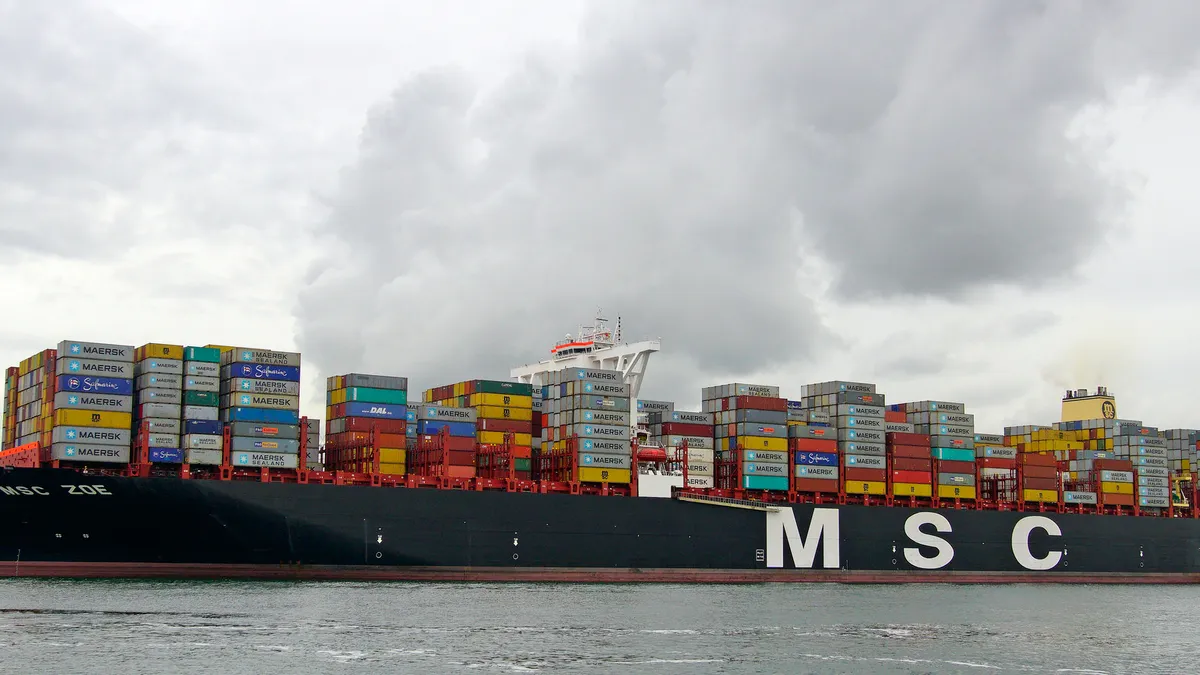UPDATE: Jan. 7, 2019: MSC said it was committed to the North Sea clean up and would fund the efforts "until the last container is found," according to a press release published Saturday. The carrier contracted Ardent Global to facilitate the efforts.
Dive Brief:
- MSC is directly taking over some clean-up efforts of German and Dutch waters and beaches, after rough waters caused one of its cargo ships to reportedly lose 270 containers at sea on Jan. 2.
- Already, eight containers of materials have been collected from the Dutch island of Terschelling, according to a statement by MSC. BBC reports 11 containers were spotted floating between the islands of Ameland and Schiermonnikoog.
- The shipping company has contracted and deployed drones, industrial-raking machines and SONAR equipment to locate the lost cargo. Local volunteers are also helping to clean up debris, leading some to raise concerns over the potential environmental damage from the accident.
Extreme pollution at #Ameland beaches after #MSCARGO vessel looses 270 #containers. Each pair of shoe was wrapped in #plastic and with silica gel bag. pic.twitter.com/hEcpg3RcpF
— Siegmund Metselaar (@smetselaar) January 3, 2019
Dive Insight:
Shoes, toys and TV's line the beaches of Dutch islands this week, and clean-up efforts are ongoing. The numbers so far and historical precedent suggest while some containers and their contents will be fully recovered, many others will remain underwater for years to come.
In 2017, the World Shipping Council (WSC) revealed on average 612 containers per year were routinely lost at sea over a three-year period. After adding in catastrophic events — such as the loss of U.S. cargo ship El Faro and its 391 containers in 2015 — the average containers lost annually rises to 1,390 each year. The WSC conducts its survey of containers lost at sea once every three years.
Unlike the cargo and debris being cleaned up after the accident this week, however, much of the cargo routinely lost at sea is never recovered.
In 2004, the Monterey Bay Aquarium Research Institute (MBARI) found a sunken shipping container on the deep sea floor. The container had been lost in February of that year as a containership traveled from Oakland to Long Beach. The vessel lost 24 containers throughout its trip.
Ten years later, MBARI published a study describing the environmental effects of sunken containers on deep-sea ecosystems. During a dive, the Institute discovered the presence of the object on the sea floor may have "indirect ecological effects," such as encouraging a higher number of predators.
But since a container may take a hundred years to fully degrade on the ocean floor, the full effects have yet to be revealed, MBARI concluded.
"We have only begun to characterize the potential long-term impacts of a single container on a deep-sea community," said MBARI's Josi Taylor in a press release at the time. "Although the effects of one container may seem small, the thousands of shipping containers lost on the seafloor each year could eventually become a significant source of pollution for deep-sea ecosystems."
The shipping community recognizes containers lost at sea are not just a business problem, but also an environmental one.
"MSC takes this incident very seriously, both in terms of the impact of such accidents on the natural environment and in terms of any damage to customers’ cargo," the shipping line said in a statement.
The World Shipping Council, meanwhile, outlined several initiatives the global industry has undertaken to reduce the number of containers lost at sea, including verified gross mass rules, revised ISO standards and updated codes for packing of cargo transport units.
"The container shipping industry's goal remains to keep the loss of containers carried on those ships as close to zero as possible," according to the WSC report. "Carriers will continue to explore and implement preventative and realistic measures to achieve that goal."














